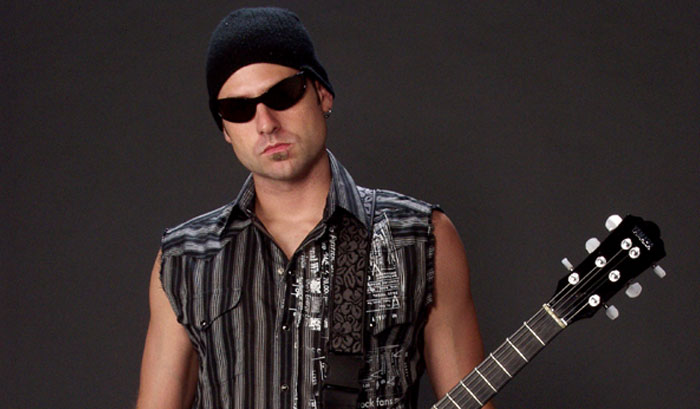


Q: What do Brazilian music, jazz, heavy metal, and dance-pop have in common?
A: Rafael Moreira
It's a long way from Moreira's birthplace of Cambara, in the Southern Brazilian state of Parana, to the concert stages he currently shares with dance-pop diva Pink. But Moreira insists that his Brazilian roots remain close to the surface.
"There's nothing I can do about it," he shrugs. "I just have it in my blood. No matter what style I play, you can hear the grooves and harmonies and laid-back attitude of Brazilian music. It's even there when I play heavy stuff."
No matter what style I play, you can hear the grooves and harmonies and laid-back attitude of Brazilian music. It's even there when I play heavy stuff.
Schooled by his pianist mother, Moreira started singing at age two, and by five he was playing guitar. Soon he was performing in concert with his mother and two brothers, who played bass and drums. The brothers also formed a rock trio, and by age nine Rafael was regularly performing before rodeo audiences numbering in the tens of thousands.
Even though Cambara lies far from any large city - there weren't even any radio stations when Rafael was growing up - Mrs. Moreira would bring stacks of the latest records each time she returned from the capital city of Sao Paulo. "I listened to everything," recalls Moreira. "Fusion, rock, and Brazilian musicians like Antonio Carlos Jobim, Djavan, Ivan Lins, Gilberto Gil, Caetano Veloso, and Milton Nascimento."
Teenaged Rafael moved to the larger town of Curitiba to study classical music, but soon found himself playing jazz with the band Lex Luthor and "melodic metal" with Icarus. Next up was the rap/metal group Nospheratu, whose style Moreira describes as "trash jazz." The group's EP became a regional hit.
The desire for music education also inspired Moreira's next big move: to Hollywood at age 21 to study at the Guitar Institute of Technology. "The GIT experience opened me up in a lot of ways," says Rafael. "I learned English, and I got to study with Scott Henderson, Joe Diorio, and Carl Schroeder." Rafael went on to win the GIT Masters Guitar Competition and was awarded a scholarship to continue his studies after graduation.
Rafael credits the "mind opening" influence of GIT with smoothing his transition from metal-fusion to pop. Now audiences know him best as an accompanist to such arena-scale pop acts as Mya, Marc Anthony, Christina Aguilera and Pink.
"Mya, Marc, and Christina were all great to work with," he says. "But Pink is the gig I've enjoyed most so far, because it's so much more like a real rock-and-roll band. I get a lot more space to play. I do solos - things like Jimi Hendrix's 'Star Spangled Banner' - and I get to run around a lot onstage. And Pink is just amazing to work with."
Moreira relies heavily on several Yamaha guitars. "With Pink, I've been using a Pacifica USA2 Custom with a Warmoth neck. That was also my main guitar with Christina - you can see me playing it on her Reflection DvD. I've also been playing a new AES recently. It's a very physically heavy solidbody, and that heaviness shows in its sound." Another current favorite is the AES1500 hollowbody electric. "It's a very versatile guitar with two DiMarzio humbuckers," explains Rafael. "I can pretty much play anything on it, from heavy metal to jazz, thanks to the beautiful, fat tone of the neck pickup. That's the guitar I use for the Janis Joplin tribute medley in Pink's show. It's great for that vintage sound."
Moreira's principle steel-string acoustic is the CPX15W Compass. "What can I say?" he chuckles. "It's a well-built guitar with an amazingly huge, warm sound that gets compliments from everybody." Moreira also has several Yamaha nylon-strings that he uses for Brazilian music. For example, on a recent recording with legendary Brazilian percussionist Airto Moreira (no relation), Rafael used an APX9NC, a thinline acoustic-electric. "We blended two channels, mic'ed and direct, and it sounded great," he reports.
Another essential studio tool is a Yamaha DG Stomp directrecording preamp. "It's the best thing out there right now for recording," raves Rafael. "I record electric guitars straight out of the box. And when I play clinics, I just take a guitar and the DG Stomp. I turn off the preamp and plug it into the effects loop of whichever amp they give me. That way, I can get distortion from the head, but still get clean effects from the DG Stomp." Moreira has similarly high marks for Yamaha's DG130H digital amp: "It's just amazing. It sounds like a tube amp."
Moreira flatly rejects the stereotype that GIT grads are soulless technicians: "GIT is just a name. It doesn't change you as a person if you have a strong personality. I'm not a big technician. I just go out there with what I have. In the end, that's the only thing you can do. You've got to be your own player."
























